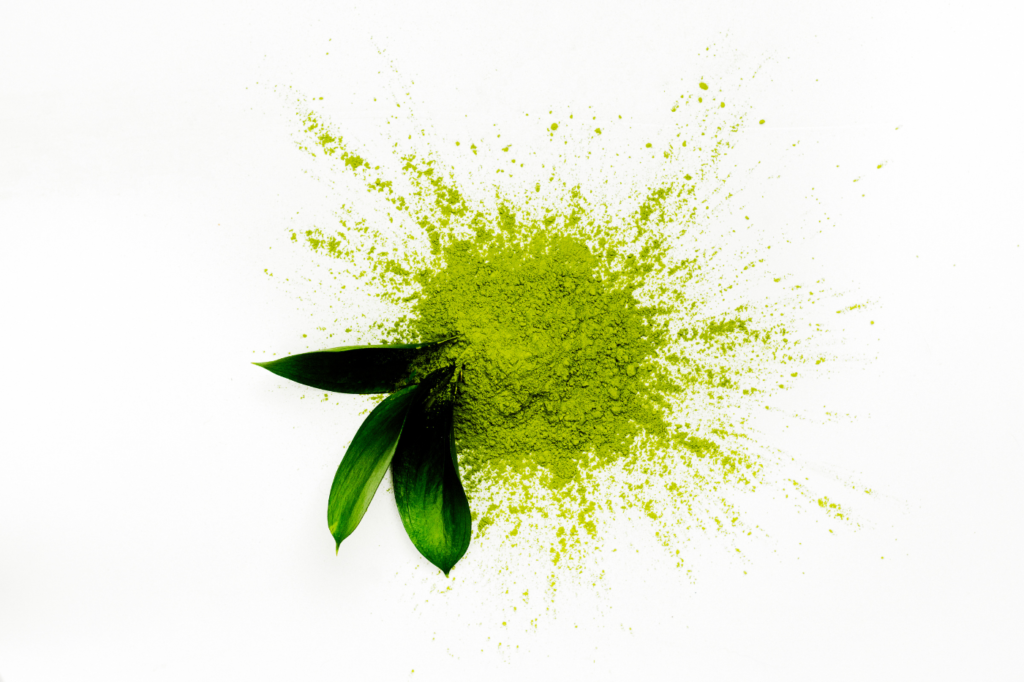A cup of green tea is not only great for the body — patients can use green tea for skin because it has many skin benefits. Many dermatologists also recommend green tea for acne because it addresses the root cause of blemishes and breakouts.
Green tea gets a lot of love for its health benefits because it’s loaded with antioxidants and anti-inflammatory compounds like catechins and polyphenols. These compounds keep skin cells healthy and combat damage caused by free radicals from sun exposure and pollution.
Benefits Of Green Tea For Acne

Green tea is one of the best natural ways to fight acne. It contains compounds like the antioxidant polyphenol EGCG (epigallocatechin gallate or epigallocatechin-3-gallate), which helps fight inflammation and reduce oxidative stress that can damage skin and cause irritation.
Green tea also contains vitamin E, a potent antioxidant. It’s also rich in vitamin B2, which helps maintain collagen levels, keeping the skin looking youthful and firm. And, it contains acne-fighting vitamins and minerals like zinc and vitamin B3.
Does green tea improve skin? Yes, green tea improves skin in many ways, including acne reduction, combatting skin cancer, and even reducing the signs of aging.
Green Tea Reduces Sebum Production
Green tea is also an excellent acne treatment because it directly reduces sebum production by the sebaceous glands in the skin. Excess sebum secretion can clog pores, causing acne and pimples. That makes green tea a perfect choice for patients with oily skin.
Green Tea Decreases Acne-Causing Inflammation
Increased inflammation can also exacerbate acne, and green tea helps fight inflammation. It’s particularly effective at fighting the inflammation that leads to acne around the nose, mouth, and chin.
Green Tea Fights Bacteria that Cause Acne
Green tea also has antibacterial and antimicrobial properties. Studies have shown that green tea extract inhibits the growth of acne-causing bacteria such as Cutibacterium acnes. Green tea extract is an excellent natural way to treat acne.
What are the benefits of green tea for acne? The benefits of green tea for acne are decreasing sebum production, reducing inflammation that leads to acne, and slowing the growth of bacteria that cause acne.
Does green tea help with acne? Yes, green tea helps with acne by fighting many factors that contribute to breakouts, including excess oil (sebum) production and acne-causing bacteria. Regular use of green tea skincare products can help clear skin and prevent acne breakouts.
How Green Tea Improves Skin Health
Green tea can make an improvement in overall skin wellness. Green tea skincare products have anti-aging properties. They help increase the skin’s elasticity, helping it look younger and healthier. Fine lines and dark circles under the eyes can fade, too.
There’s evidence that green tea can also help fight psoriasis, keratosis, and rosacea. Green tea’s polyphenols help regulate certain enzymes in skin cells so that they grow and develop properly.
The compounds in green tea like EGCG can fight skin cancer. The anti-cancer properties of EGCG and the other polyphenols in green tea help it combat sun damage from UV rays, reduce inflammation from UV radiation, and downregulate pathways that lead to tumor formation.
What are the benefits of green tea for skin? The benefits of green tea for skin are the reduction and elimination of acne, protection against sun damage and skin cancer, and younger-looking skin due to green tea’s anti-aging properties.
How Green Tea For Acne Works

There are two ways patients can use green tea to treat acne and other skin issues: drinking green tea and applying products containing green tea.
These products can include cleansers, toners, and moisturizers, directly to the skin. Skin gets the benefit of green tea’s anti-inflammatory properties either way.
Everyone’s skin is different, so patients may need to use a little trial and error until you find a system that works well for them. It may take a few weeks to see results after adding green tea to a skincare routine.
Drinking green tea for the skin can be highly beneficial. Because green tea is made with the unoxidized leaves of the Camellia sinensis plant, it has more antioxidants than black tea. Unoxidized green tea leaves are lighter in color because they don’t contain many tannins.
How To Use Green Tea
It’s relatively easy to use green tea to fight and treat skin conditions like acne, make skin look younger, and help skin glow. You can purchase skin care products containing green tea extract or mix up home remedies yourself.
Some of the most common ways to use green tea in skincare are:
- Drinking green tea: Drinking green tea delivers antioxidants and anti-inflammatory compounds to the entire body, including your skin. It helps with hydration, as well.
- Face masks: Make a homemade face mask by mixing Japanese matcha green tea powder, aloe vera gel, and apple cider vinegar. Another option is to take the moistened leaves from 1-2 green tea bags and mix them with aloe vera gel.
- Eye care: Placing chilled steeped green tea bags on the eyes can help eliminate puffiness and even reduce dark circles. I love this quick and simple natural beauty hack!
- Lotions and creams: Green tea is an ingredient in many lotions and creams. Alternatively, you can mix their own by adding powdered green tea or green tea extract to your favorite products, including sunscreen.
- Toner: Toners made with green tea help eliminate excess sebum and oil while delivering green tea to the skin, so they can be great options for acne sufferers.
- Facial scrubs: Facial scrubs with green tea help exfoliate skin and remove dead skin cells while delivering green tea directly to the skin.
- Supplements: Green tea supplements give the body large doses of antioxidants and anti-inflammatory compounds, which will travel through the bloodstream to the skin.
These treatments are generally safe for all skin types. Patients with very sensitive skin can check with their dermatologist first about potential side effects before using.
What type of green tea is best for skin? The type of green tea best for skin is matcha green tea powder or whole green tea leaves. These types of green tea are minimally processed, so the skin gets more of green tea’s antioxidant properties.
How can I use green tea on my face? You can use green tea on your face by using a green tea face mask, adding powdered green tea to your skincare products, or buying commercially available products made with green tea.
Other Teas For Acne

Other types of tea are also helpful for fighting inflammatory acne. Here are teas to try to keep your skin clear:
- Spearmint tea: Spearmint tea reduces androgen hormone production, which helps improve acne.
- Peppermint tea: Peppermint tea, like spearmint tea, has been shown to reduce testosterone levels in animal studies. Its balancing effect is also great for hormonal acne.
- Chamomile tea: Chamomile tea can help soothe irritated acne-prone skin, reducing irritation and inflammation that can make acne worse.
Is green tea good for your skin? Yes, green tea is good for your skin. Its antioxidants and anti-inflammatory compounds keep skin healthy and can even help fight skin cancer.
Ready to use green tea for your skincare?
If you’re curious about using green tea for your skin type and needs, make an appointment with your dermatologist. They will be able to recommend products that will support your skin health without being too harsh.
You can also learn more about using green tea skincare in my course, The SkinClock Method. You’ll learn how to keep your skin looking healthy and youthful from the inside out. It’s everything I tell my patients in one convenient online course. You don’t want to miss this!
Sources
- Carloni, P., Tiano, L., Padella, L., Bacchetti, T., Customu, C., Kay, A., & Damiani, E. (2013). Antioxidant activity of white, green and black tea obtained from the same tea cultivar. Food Research International, 53(2), 900-908. Abstract: https://pubag.nal.usda.gov/catalog/1125794
- Mahmood, T., Akhtar, N., & Moldovan, C. (2013). A comparison of the effects of topical green tea and lotus on facial sebum control in healthy humans. Hippokratia, 17(1), 64–67. Abstract: https://pubmed.ncbi.nlm.nih.gov/23935347/
- Makrantonaki, E., Ganceviciene, R., & Zouboulis, C. (2011). An update on the role of the sebaceous gland in the pathogenesis of acne. Dermato-Endocrinology, 3(1), 41–49. Abstract: https://pubmed.ncbi.nlm.nih.gov/21519409/
- Lu, P. H., & Hsu, C. H. (2016). Does supplementation with green tea extract improve acne in post-adolescent women? A randomized, double-blind, and placebo-controlled clinical trial. Complementary Therapies in Medicine, 25, 159–163. Abstract: https://pubmed.ncbi.nlm.nih.gov/27062963/
- Kim, S., Park, T. H., Kim, W. I., Park, S., Kim, J. H., & Cho, M. K. (2021). The effects of green tea on acne vulgaris: A systematic review and meta-analysis of randomized clinical trials. Phytotherapy Research, 35(1), 374–383. Abstract: https://pubmed.ncbi.nlm.nih.gov/32812270/
- Chiu, A. E., Chan, J. L., Kern, D. G., Kohler, S., Rehmus, W. E., & Kimball, A. B. (2005). Double-blinded, placebo-controlled trial of green tea extracts in the clinical and histologic appearance of photoaging skin. Dermatologic Surgery, 31(7 Pt 2), 855–860. Abstract: https://pubmed.ncbi.nlm.nih.gov/16029678/
- Hsu S. (2005). Green tea and the skin. Journal of the American Academy of Dermatology, 52(6), 1049–1059. Abstract: https://pubmed.ncbi.nlm.nih.gov/15928624/
- Katiyar, S. K., & Elmets, C. A. (2001). Green tea polyphenolic antioxidants and skin photoprotection (Review). International Journal of Oncology, 18(6), 1307–1313. Abstract: https://pubmed.ncbi.nlm.nih.gov/11351267/
- Grant, P., & Ramasamy, S. (2012). An update on plant derived anti-androgens. International Journal of Endocrinology and Metabolism, 10(2), 497–502. Abstract: https://pubmed.ncbi.nlm.nih.gov/23843810/
- Akdogan, M., Ozguner, M., Kocak, A., Oncu, M., & Cicek, E. (2004). Effects of peppermint teas on plasma testosterone, follicle-stimulating hormone, and luteinizing hormone levels and testicular tissue in rats. Urology, 64(2), 394-398. Abstract: https://pubmed.ncbi.nlm.nih.gov/19585478/
